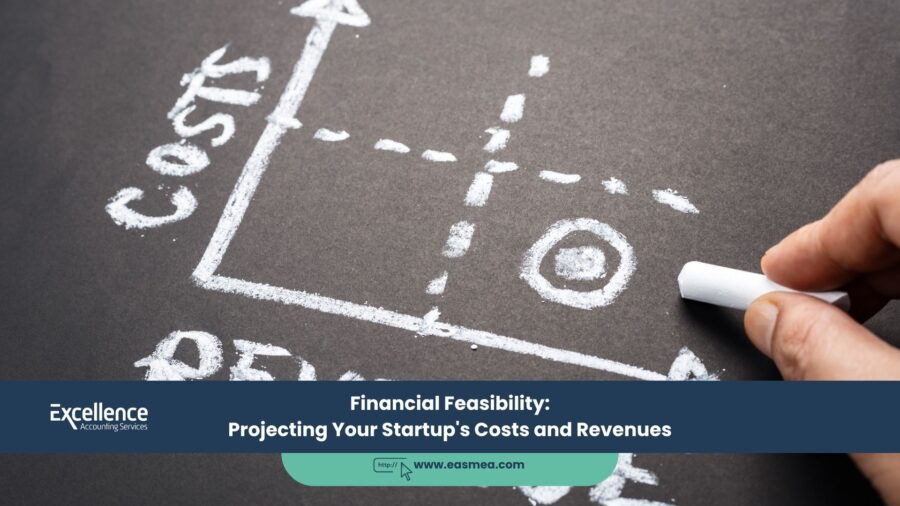Financial Feasibility: Projecting Your Startup’s Costs and Revenues
For a startup founder in Dubai, your vision is the spark. But to attract investors and secure loans, you need to prove that your spark can ignite a profitable fire. This is the purpose of a Financial Feasibility Study. It is the most critical and scrutinized component of any business plan or feasibility study, translating your ideas, market research, and operational plans into the universal language of business: money.
- Financial Feasibility: Projecting Your Startup's Costs and Revenues
- Step 1: Projecting Your Startup Costs
- Step 2: Forecasting Your Startup's Revenues
- Step 3: Building Your Projected Financial Statements
- Step 4: Calculating Key Financial Metrics
- From Idea to Investor-Ready Financials with EAS
- Frequently Asked Questions (FAQs)
- Is Your Vision Financially Viable?
A financial feasibility analysis is not a work of fiction. It is a rigorous, data-driven forecast of your startup’s financial future. It’s where you move from “we think we can be profitable” to “here is our detailed, assumption-led plan to achieve a 25% net margin by Year 3.” For investors and banks in the competitive Dubai market, a well-constructed financial forecast is the ultimate proof of concept. It demonstrates that you have a deep understanding of your business’s economic engine and have thought critically about the path to sustainability and profitability.
This guide will walk you through the essential steps of building a robust financial feasibility study for your startup. We will cover how to realistically project your costs, how to build a defensible revenue forecast, and how to assemble these components into the financial statements that investors demand to see. Mastering this process is fundamental to turning your entrepreneurial vision into a bankable business proposition.
Key Takeaways
- Financial Feasibility is Proof: It’s the process of proving to investors that your business idea is not just innovative but also financially viable and profitable.
- Costs Come First: Accurately projecting your one-time startup costs (CAPEX) and recurring operational costs (OPEX) is the foundation of your financial model.
- Revenue Forecasts Must Be Defensible: Use a bottom-up or top-down approach with clear, data-backed assumptions to project your sales. Avoid purely aspirational numbers.
- The 3 Core Statements: Your projections must be presented in the form of a projected Income Statement, Cash Flow Statement, and Balance Sheet.
- Cash Flow is King: For investors, the Cash Flow Statement is often the most critical, as it shows the actual cash-generating ability of the business and its capacity to survive.
- Expert Modeling is a Smart Investment: The complexity of building an integrated financial model makes professional help from a Fractional CFO or advisory firm invaluable.
Step 1: Projecting Your Startup Costs
Before you can think about revenue, you must have a crystal-clear picture of your costs. A common mistake founders make is underestimating expenses, which can lead to running out of cash prematurely. Your costs should be broken down into two categories.
A. One-Time Startup Costs (Capital Expenditures – CAPEX)
These are the initial, one-off investments required to get your business off the ground. They are capitalized on your balance sheet and depreciated over time.
- Legal & Licensing Fees: Costs for company formation, trade license issuance in Dubai, and any specific government permits.
- Office/Retail Fit-Out: The cost of renovating and furnishing your physical space.
- Purchase of Assets: The cost of machinery, computer equipment, vehicles, and other long-term assets.
- Initial Inventory: The cost of your first major stock purchase.
- Website & Software Development: The initial cost to build your e-commerce site or proprietary software.
B. Recurring Operational Costs (Operating Expenditures – OPEX)
These are the ongoing monthly or annual expenses required to run the business. They are recorded on your income statement.
- Salaries & Wages: Including employee salaries, benefits, and gratuity provisions. Our payroll services can help accurately forecast this.
- Rent & Utilities: The monthly cost of your office, warehouse, or retail space, plus electricity (DEWA), internet, etc.
- Marketing & Advertising: Your budget for digital marketing, social media, PR, and other promotional activities.
- Software Subscriptions: Monthly fees for tools like CRM, project management, and accounting software like Zoho Books.
- Professional Fees: Costs for legal, accounting, and consulting services.
- Cost of Goods Sold (COGS): For product businesses, this is the direct cost of the inventory you sell.
Be thorough and conservative. It’s always better to overestimate your costs slightly than to underestimate them. Research real quotes from suppliers in Dubai to make your estimates as accurate as possible.
Step 2: Forecasting Your Startup’s Revenues
Projecting revenue is often the most challenging part of a financial forecast, especially for a pre-revenue startup. Your forecast must be ambitious enough to excite investors but grounded in a logical, defensible methodology.
Top-Down vs. Bottom-Up Forecasting
- Top-Down Approach: This method starts with the total market size (TAM) and estimates your potential market share. For example: “The online fashion market in the UAE is AED 10 billion. We aim to capture 0.1% of this market in Year 1, resulting in AED 10 million in revenue.” This approach is good for showing the scale of the opportunity but can be seen as less credible if not supported by a clear execution plan.
- Bottom-Up Approach: This is the preferred method for most investors as it is based on your own operational drivers. It starts with the fundamental drivers of your business. For example: “Our sales team can make 50 calls per day. We expect a 2% conversion rate, resulting in 1 new customer per day. Our average sale price is AED 1,000. Therefore, we project AED 1,000 in revenue per salesperson per day.” This method ties your revenue directly to your activities and resources.
A strong forecast often uses a bottom-up approach to build the projection and a top-down approach as a sanity check to ensure the numbers are reasonable within the context of the overall market.
Step 3: Building Your Projected Financial Statements
Once you have your cost and revenue projections, you must assemble them into a set of integrated financial statements for the next 3-5 years. “Integrated” means that a change in one statement correctly flows through to the others.
1. The Income Statement (Profit & Loss)
This statement shows your profitability over a period. It follows a simple formula: Revenues – Cost of Goods Sold – Operating Expenses = Net Profit/Loss. This is where you demonstrate your project’s earning potential.
2. The Cash Flow Statement
For investors, this is often the most important statement. Profit is an accounting concept, but cash is reality. This statement tracks the actual cash moving in and out of your business from three activities: Operations, Investing, and Financing. It answers the critical question: “Will the business generate enough cash to pay its bills and repay its debts?”
3. The Balance Sheet
This provides a snapshot of your company’s financial health at a single point in time. It follows the fundamental accounting equation: Assets = Liabilities + Equity. It shows what your business owns (assets) and what it owes (liabilities and owner’s equity).
Step 4: Calculating Key Financial Metrics
Your financial model should conclude with the key metrics that investors use to appraise a project’s viability.
| Metric | What It Measures | What Investors Want to See |
|---|---|---|
| Net Present Value (NPV) | The total value of all future cash flows, discounted to today’s value, minus the initial investment. | A positive number. The higher, the better. |
| Internal Rate of Return (IRR) | The project’s annualized rate of return. | An IRR that is significantly higher than the project’s cost of capital (the required rate of return). |
| Payback Period | The time it takes for the project to generate enough cash to cover the initial investment. | A shorter payback period is generally preferred as it indicates lower risk. |
| Break-Even Point | The level of sales at which total revenues equal total costs. | A low break-even point that can be achieved quickly. |
From Idea to Investor-Ready Financials with EAS
Building a robust, integrated, and defensible financial model is a specialized skill. At Excellence Accounting Services (EAS), we transform your business assumptions into a professional financial feasibility study that stands up to investor scrutiny.
Our Financial Feasibility Services:
- Comprehensive Financial Modeling: We build detailed 3-5 year financial projections, including all three financial statements and key performance metrics.
- Cost and Revenue Forecasting: We work with you to develop realistic, data-backed projections for all your startup costs and potential revenue streams.
- Scenario & Sensitivity Analysis: We build models that can test different scenarios (base, best, worst case) to demonstrate your project’s financial resilience.
- Investor-Ready Reports: We present our findings in a clear, professional report designed to give investors and banks the confidence to fund your venture.
Frequently Asked Questions (FAQs)
Lorem ipsum dolor sit amet, consectetur adipiscing elit. Ut elit tellus, luctus nec ullamcorper mattis, pulvinar dapibus leo.
This is where the bottom-up approach is essential. You must base your forecast on tangible drivers. For example: the number of sales calls you can make, your website’s expected traffic and conversion rate, or the capacity of your production facility. You can also use data from market research reports or find benchmarks from similar, more established companies.
For a startup seeking funding, a 3 to 5-year forecast is standard. This is a long enough period to show the business reaching a stable, profitable state, but not so long that the assumptions become pure speculation.
A sensitivity analysis is a crucial part of a financial model where you test how changes in your key assumptions (e.g., a 10% decrease in sales price or a 20% increase in customer acquisition cost) affect your overall profitability and cash flow. It shows investors that you have considered risks and understand your business’s key value drivers.
Be as detailed as possible. Break down costs into specific line items. Instead of just “Marketing,” break it down into “Google Ads,” “Social Media Management,” “PR Retainer,” etc. This demonstrates thorough research and planning.
Yes. Even if you don’t plan to draw a full market-rate salary initially, you must include a reasonable salary for the founders in the operational expenses. This presents a more realistic picture of the company’s long-term cost structure. Investors will expect this.
Working capital is the cash a business needs for its day-to-day operations. It’s calculated as Current Assets (like accounts receivable and inventory) minus Current Liabilities (like accounts payable). Your initial project cost must include an injection of working capital to cover the gap before your business starts generating positive cash flow.
No, they are not a legal guarantee of future performance. However, if you are found to have knowingly and deliberately misrepresented facts or made fraudulent assumptions to secure funding, there could be serious legal consequences. The projections must be made in good faith and based on reasonable assumptions.
A negative Net Present Value (NPV) means that, based on your current assumptions, the project is expected to lose money in today’s terms. It is a clear signal that the project is not financially viable as currently planned. You would need to re-evaluate your assumptions, find ways to reduce costs, or increase revenues to make the project feasible.
Because “cash is king.” A company can be profitable on paper (according to the Income Statement) but still go bankrupt if it runs out of cash. The Cash Flow Statement shows the actual cash generation and burn rate. It proves the business can survive, pay its bills, and ultimately provide a cash return to investors, which is their primary concern.
Conclusion: The Financial Blueprint for Success
A well-researched, logically structured, and defensible financial feasibility study is the most persuasive document a founder can create. It is your financial blueprint, demonstrating to the world that your startup is not just a dream but a viable commercial enterprise with a clear path to profitability. By investing the time and effort (and often, expert help) to get your projections right, you are not just completing a task for investors; you are creating an invaluable strategic tool for your own decision-making and building a solid foundation for your startup’s future in Dubai.
Is Your Vision Financially Viable?
Our experts specialize in building robust financial models for startups, turning your vision into a credible plan that gets funded.




